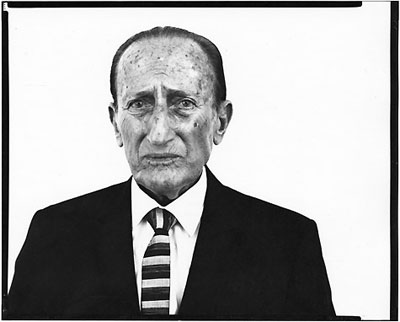 Richard Avedon: Jacob Israel Avedon, father of Richard Avedon, Sarasota, Florida, 1969-1973 14 x 11 inches © The Richard Avedon Foundation Arbus, Avedon, Sander Pace/MacGill Gallery is pleased to present "Arbus, Avedon, Sander," an exhibition of three equally important and distinctly different bodies of work by Diane Arbus, Richard Avedon and August Sander. The exhibition addresses the visual power and conceptual foundations of the extended portrait in photography and includes nine prints from Arbus's "Untitled" series, seven prints from Avedon's portfolio "Jacob Israel Avedon, Sarasota, Florida," and twelve prints from Sander's "Die Stammappe" portfolio. As a medium, photography encourages the repeated, serial examination of a subject over time. Arbus, Avedon and Sander each chose to examine their subjects differently and their investigations yielded varied yet equally compelling results. Viewed together, the three photographers' work becomes a powerful statement of what photography can be in the hands of several of the medium's most accomplished practitioners. Working before the widespread embrace of digital technology, Sander, Avedon and Arbus understood the importance of remaining faithful to what they understood was real and dedicated their inventive efforts to representing the world around them without artifice. "Nothing seemed more appropriate to me than to render through photography a picture of our times which is absolutely true to nature." (August Sander, Cologne, 1927) For August Sander (1876-1964), "Die Stammappe" served as the blueprint for his life's work "People of the 20th Century." The Stammappe portfolio is devoted to country people who, for Sander, embodied the essence of what he defined as being "universally human." With a single exception dating from 1925, the twelve portraits in the portfolio were taken between 1910 and 1914 in the Westerwald region of Germany. Himself born in the rural countryside, the men and women Sander portrays in his pictures are similar to the idiosyncratic individuals he knew from his childhood, yet he depicts them "according to their essential archetype, with all the characteristics of mankind in general." The portfolio in Pace/MacGill's exhibition is from the Sander family's private collection. It is one of six portfolios known to exist, and the only one outside of public collections. "When you pose for a photograph, it's behind a smile that isn't yours. You are angry and hungry and alive. What I value in you is that intensity. I want to make portraits as intense as people." (Richard Avedon, from a 1970 letter to his father) Following a period of estrangement from his father Jacob Israel Avedon, Richard Avedon sought a way to reconnect with him. Having already established a reputation for his work as a portrait photographer, Avedon (1923-2004), asked his father if he would agree to be photographed. The elder Avedon agreed and his son took pictures of him annually beginning in 1969 and documented his struggle with cancer until his death in 1973. The seven portraits included in the exhibition are unflinchingly candid and poignantly convey Jacob Avedon's struggle to survive with dignity until life's end. "It's the first time that I've encountered a subject where the multiplicity is the thing. I mean I'm not just looking for the BEST picture of them. I want to do lots ... I really adore them." (Diane Arbus, in a 1969 letter to Allan Arbus) In keeping with her long-standing interest in subcultures and self-contained miniature societies, Diane Arbus (1923-1971) began making pictures around 1969 at New Jersey homes for the mentally disabled. Over a period of about two years, she visited the homes during special events: picnics, dances, Halloween. Like all of Arbus's work, these photographs reflect her scrupulous attention to the facts and her faith in the lucidity of appearances as "the signs and symptoms of reality." Paradoxically however, these pictures often seem to have as much in common with the mythic as the documentary. Exhibition: January 10 - February 16, 2008 Gallery hours: Tues-Fri 9:30 am - 5:30 pm, Sat 10 - 6 pm Pace/MacGill Gallery 32 East 57th Street, 9th floor USA-New York, NY 10022 Telephone +1 212 759 7999 Fax +1 212 759 8964 Email info@pacemacgill.com www.pacemacgill.com |